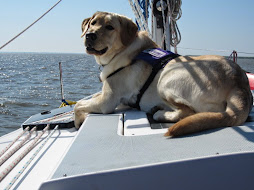When you see our dogs in advanced training, you may see them
wearing a Comfort Trainer, which is a type of head halter or collar. The
Comfort Trainer can be a valuable tool for people who have service dogs,
especially if they do not have the strength to handle a bigger dog in some
situations. In those situations, the Comfort Trainer helps keep the person safe
while they work with their life-changing service dog.
However, it’s important to remember that a Comfort Trainer
or other head collar is never a replacement for training good loose leash
walking. A dog that walks perfectly on a loose leash while wearing a head
collar must also walk perfectly on a loose leash with a flat collar.
For example, our director, Nancy, took SSD Meade to the
Highmark Walk for a Healthy Community last Saturday, and she decided to use a
Comfort Trainer, even though Meade doesn’t usually wear one. She had been
having some walking issues, but finishing the entire 5K Walk was important to
her. She knew that the Walk would have lots of distractions for Meade and he
would want to pull even though he’s normally good at loose leash walking, so
she introduced the Comfort Trainer for her own safety.
By the morning of the Walk, Meade had adjusted to the
Comfort Trainer, and he did a great job staying right by Nancy’s side for the
entire 5K!
However, when Nancy and Meade did a meet & greet later
that day, she decided not to use the Comfort Trainer, and something strange
happened. Meade started pulling. He had no self control. The next day, Nancy
took Meade back to the same location, using a regular flat collar, and Meade
did wonderfully, even though there were more distractions than the previous
day.
So why did Meade, who is normally very good at loose leash
walking, pull so hard after the comfort trainer had come off?
The answer, Nancy believes, lies in teaching the dog self
control.
At SSD, we work really hard to teach our dogs to have self
control. They must wait at their food dish until they’re released to eat. They
must walk through a doorway, turn around, and look at us rather than simply
charging through. They must ignore food dropped on the floor, stay calm while
being petted, and never jump on friends and visitors. One of our puppy raisers’
biggest jobs is teaching self control.
The hardest lesson in self control is loose leash walking. It
requires constant vigilance and consistency. Dogs must never be allowed to
pull. We start training loose leash walking when the dogs are just puppies, and
we continue working on it for their entire lives.
If a dog pulls, a head collar of any kind never fixes the
problem. A head collar will help keep you safe if you have a serious physical
issue, but it will never teach your dog loose leash walking or self control.
When Meade wore the Comfort Trainer for the Highmark Walk for a Healthy
Community, he didn’t have to exercise self control to stay by Nancy’s side.
Once the head collar came off, he decided that he still didn’t need to use self
control, so he pulled and pulled during the demonstration.
If you need to use a head collar for safety reasons, make
sure to practice loose leash walking with a flat collar in easier places. The
goal is to train your dog so that he or she has the self control to walk on a
loose leash attached to a flat collar. If loose leash walking is very
challenging for your SSD dog, please talk to us or to one of our wonderful
puppy raiser mentors. We’re happy to help.










No comments:
Post a Comment